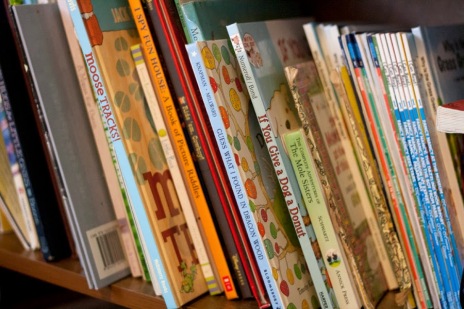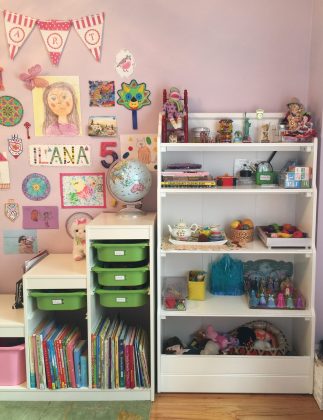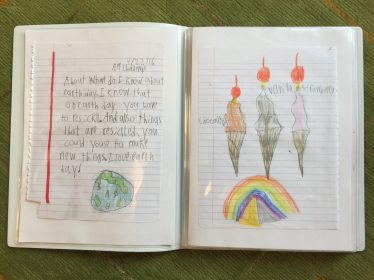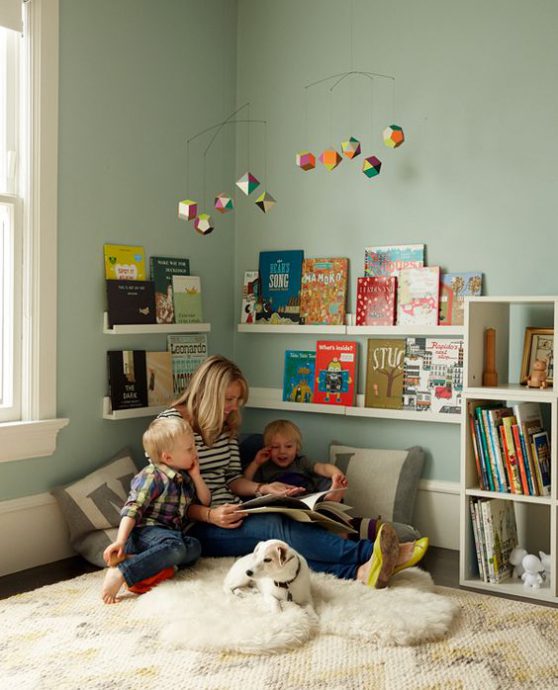If you are ready for the next step in organizing your kid’s room, let’s talk Books and let’s talk Paper.
Organizing Books
Books have great reputation. We know reading is important for our children and our tolerance for having too many children’s books around the house is usually pretty high compared to broken trains and random pieces of legos on the floor. And yet, there comes a point when we can’t fit any more new books on the shelves and start secretly wishing that half of them could just magically disappear.
The disappearing part is not easy though: throwing books away feels like a moral crime, selling them is a mute point, and figuring out where to donate them is a project like anything else. So, where do we go from here?
I’d say declutter regardless of your concerns. Once you leave only those books that truly spark joy for you and your child, you’ll be able to experience what a smaller but well curated collection of books can do for your child’s development and your reading time together.
Kon Mari organization method tackles books right after clothes. It is the second easiest category to declutter but you have to follow the main rule and that is taking all of your children’s books off the shelves and putting them in one big pile on the floor. Even if you have three bookcases full.
Do not assume that you can decide what to keep just by looking at the spines of the books on the shelves. The books that have not been touched in a while are dormant. They are essentially wall paper. Most of them have fulfilled their purpose in your child’s life and have been internalized even if she doesn’t remember the contents, but we still keep them on the shelf because they are, well, books.

To get in touch with your feelings about each book, you have to take it in your hands, feel it, smell it, and experience its main message anew. Also, getting all of your children’s books assembled in one spot on the floor will show you just how many you actually have.
Books are great to review with your children but you have to do the prep work first. Once the books are out on the floor, sort them into categories. When I was decluttering my daughter’s books, I made 3 piles: Russian-language fiction, English-language fiction, and all non-fiction (educational, reference, art books, etc). Categorize based on what makes sense for your book collection.
Next, go through each category on your own and eliminate the obvious candidates – books with simple texts and pictures your children already outgrew, books your child never wants to read when you suggest then, etc. Be careful not to discard your child’s favorites. If in doubt, leave them in the pile and review them together later.
A note on textbooks. This is hardly a category to review with younger children, so you can call the shots on those. Just make sure you discard all textbooks and workbooks that already fulfilled their purpose. Clear room for more learning!
Once the preliminary sorting is done, invite your child. Just seeing all their books stacked on the floor will get their attention. Ask her to take each book in her hands and tell you if she wants to keep it. Be ready to get lots of “Oh, can we read this RIGHT NOW?”. That’s a great sign. Promise to read it soon and make a mental note. This is a great example when a book sparks joy for your child and that’s a keeper!
If your child wants to hold on to a chewed board book you read to her when she was 3, by all means let her. Our selection criteria is not what’s practical for us but what sparks joy for them. That’s if you ever want them to learn to love reading. In fact, you might want to display your child’s early favorites as a special collection.
When your child shows no emotion for a certain title or tells you straight she does not want it, thank her for her choice and respectfully set that book aside. Do not let it fly across the room or shove it into a garbage bag. Explain that books are highly valuable and that you are going to donate them to your local library or friends with younger children.
I predict that by the end of your session you’ll have a sizable stack of books you are ready to part with. Here are 5 suggestions on how to send your books on their next journey:
- Donate to your local public library. Books have to be in good condition. Call ahead to check on details and ask for a tax write-off when you are there.
- Donate books to preschool or pre-k place your child attended
- If you have friends with younger children, ask if they want your books — it’s ok to bring them 2-3 titles without asking them but don’t dump a bag of books on them without asking if they want them first.
- Bring books to the nearest Salvation Army. They can also give you a tax write-off receipt.
- Place a box labeled “Free Books” on a sidewalk near your building or house
Now that you are left only with books that spark joy, dust them off and look for the best place to store and display them. Check if you can arrange books on lower shelves and organize them by category to make selection process easier for your child.

I used to store my daughter’s books on the upper shelves of the white bookcase shown above, which means that I was the one picking a book to read most of the time. I got rid of two bottom drawers in the Ikea toy storage unit and moved the books down.
We also have a nice wall-mounted book rack that displays front covers versus book spines. These are great for younger readers and are perfect for a cozy reading nook you might want to create.

Need inspiration for book storage? Check out my Pinterest board.
Organizing Paper
Paper is a tough category for adults and decluttering it is little joy. Luckily, paper rarely invades kids’ rooms and your goal should be to keep it that way.
If I may guess, your child’s school makes sure there is a steady flow of paper into your home: a letter to read, a form to fill out. Yesterday was the first day of school and our 2nd grade teacher asked us to: download Class Messenger, place Scholastic book order online, fill out lunch form, fill out medical form, fill out pick up authorization form and read her welcome letter. Well, that was a bit too much and none of that should find its way into the kid’s room. All papers that require parents’ attention should be moved to either parent’s Pending File and dealt with as soon as possible.
Another category of paper related to children are papers that need to be saved for extended period of time and used infrequently. This can be medical records, test results, enrollment forms, payment receipts, etc. Those don’t belong in your child’s room either. Save them with other papers of this sort in your office or elsewhere. It’s enough to create just one folder for all of your child’s papers that need to be saved.
The final category are papers related to study materials. These do belong in your child’s room and the trick here is not to over categorize them. Simply designate one drawer for all papers related to school work, including single sheets, workbooks, reference materials, etc. Review the contents of study materials on a regular basis and discard worksheets that are no longer needed.
There is one thing that came up for me in relation to paper. Some homework that comes back home after the teacher checked it sparks so much joy for me that I feel like saving it. In fact, it is no longer paper.  It becomes a sentimental item I want to preserve. To avoid cluttering up the drawer designated for current school work, I use a high quality presentation book with clear plastic sleeves and when I stumble upon a page of school writing or drawing I want to preserve, I simply slip it in there. At the end of the school year, this collection can be reviewed and downsized as needed.
It becomes a sentimental item I want to preserve. To avoid cluttering up the drawer designated for current school work, I use a high quality presentation book with clear plastic sleeves and when I stumble upon a page of school writing or drawing I want to preserve, I simply slip it in there. At the end of the school year, this collection can be reviewed and downsized as needed.
This leads me to the last point of this article. What do you do with your child’s artwork? All those fabulous (and sometimes not so fabulous) drawings, paintings, and crafts? Please know that children’s artwork belongs to sentimental category rather than paper and should be addressed as such later in your tidying up process. I will cover Sentimental category at length in my next post.
Next categories: toys, sentimental items
